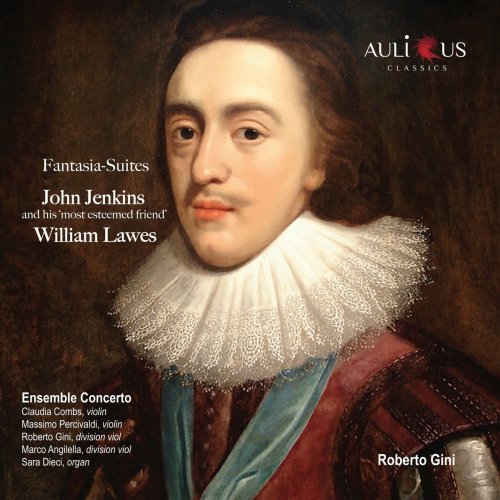
Roberto Gini - Fantasia-Suites: John Jenkins and his ‘most esteemed friend’ William Lawes (2023)
BAND/ARTIST: Roberto Gini, Ensemble Concerto
- Title: Fantasia-Suites: John Jenkins and his ‘most esteemed friend’ William Lawes
- Year Of Release: 2023
- Label: Aulicus Classics
- Genre: Classical
- Quality: FLAC (tracks+booklet)
- Total Time: 66:01 min
- Total Size: 327 MB
- WebSite: Album Preview
Tracklist:
01. Fantasia-Suite in G Minor for Two Trebles, Two Basses and Organ: I. Fantasia
02. Fantasia-Suite in G Minor for Two Trebles, Two Basses and Organ: II. Almain
03. Fantasia-Suite in G Minor for Two Trebles, Two Basses and Organ: III. Corant
04. Fantasia-Suite in C Minor for Two Trebles, Two Basses to the Organ: I. Fantasia (1)
05. Fantasia-Suite in C Minor for Two Trebles, Two Basses to the Organ: II. Aire (2)
06. Fantasia-Suite in C Minor for Two Trebles, Two Basses to the Organ: III. Aire (3)
07. Newark Siege: I. Pavan
08. Newark Siege: II. Galliard
09. Newark Siege: III. Air
10. Fantasia-Suite in C Minor for Two Trebles, Two Basses to the Organ: I. Fantasia (4)
11. Fantasia-Suite in C Minor for Two Trebles, Two Basses to the Organ: II. Aire (5)
12. Fantasia-Suite in C Minor for Two Trebles, Two Basses to the Organ: III. Aire (6)
13. Fantasia-Suite in A Minor for Two Trebles, Two Basses and Organ: I. Fantasia
14. Fantasia-Suite in A Minor for Two Trebles, Two Basses and Organ: II. Almain
15. Fantasia-Suite in A Minor for Two Trebles, Two Basses and Organ: III. Corant
01. Fantasia-Suite in G Minor for Two Trebles, Two Basses and Organ: I. Fantasia
02. Fantasia-Suite in G Minor for Two Trebles, Two Basses and Organ: II. Almain
03. Fantasia-Suite in G Minor for Two Trebles, Two Basses and Organ: III. Corant
04. Fantasia-Suite in C Minor for Two Trebles, Two Basses to the Organ: I. Fantasia (1)
05. Fantasia-Suite in C Minor for Two Trebles, Two Basses to the Organ: II. Aire (2)
06. Fantasia-Suite in C Minor for Two Trebles, Two Basses to the Organ: III. Aire (3)
07. Newark Siege: I. Pavan
08. Newark Siege: II. Galliard
09. Newark Siege: III. Air
10. Fantasia-Suite in C Minor for Two Trebles, Two Basses to the Organ: I. Fantasia (4)
11. Fantasia-Suite in C Minor for Two Trebles, Two Basses to the Organ: II. Aire (5)
12. Fantasia-Suite in C Minor for Two Trebles, Two Basses to the Organ: III. Aire (6)
13. Fantasia-Suite in A Minor for Two Trebles, Two Basses and Organ: I. Fantasia
14. Fantasia-Suite in A Minor for Two Trebles, Two Basses and Organ: II. Almain
15. Fantasia-Suite in A Minor for Two Trebles, Two Basses and Organ: III. Corant
The expression Fantasy-Suite was adopted in modern times to define a genre typical of seventeenth century English instrumental music, to which the contemporaries did not feel the need to give a name. We, however, designate by that term a model that had its origin in the 24 Fantasy-Suites by Giovanni Coprario (as John Cooper or Cowper, ca. 1575 – 1626 called himself, italianising his name). Scored for violin, or two violins, and viola da gamba “to the organ” (a prescribed organ part and not reduced to the basso continuo line), these compositions are typically divided into three movements: Fantasia - Almain -Galliard. Coprario conceived the Fantasy-Suite for his viola da gamba student, the Prince of Wales and future King Charles I of England (1600 - 1649), in which he performed the viol part. It was in this context that the latter met William Lawes (1602 - 1645), two years younger and also a student of Coprario, a meeting that was the beginning of an intense friendship. The future King often went to Hertford, where William lived, with Count Edward Seymour who was a patron of both the teacher and the student, and with whom Coprario was customary to play in consort. Coprario became composer-in-ordinary to the Court in 1625. His formal model was adopted and developed by William Lawes and John Jenkins (1592 - 1678) durino the era of the reign of Charles I; subsequently by John Hingeston (ca 1610 - 1683) in the period of Oliver Cromwell’s Commonwealth of England and again by Jenkins and Christopher Gibbons (1615-1676) after the Restoration of 1660. Lawes paid a tribute of gratitude to his teacher in the beautiful Paven of Coprario (for harp, violin, viola da gamba and theorbo) but especially in the 16 Fantasy-Suites that have reached us in manuscript. The violin is prescribed in the manuscripts of Coprario and Lawes; in those of Jenkins, instead, the upper part is often indicated by the generic term Treble. However, if on one hand Jenkins’ music may have been conceived in an environment where the descant viol was still played (mainly in viol consorts), on the other hand the style of writing and coherence with the compositions of his contemporaries and friends like Lawes, let us imagine that also in Jenkins’ Fantasy-Suites it was the violin to dialogue with the bass viol (or Division-Viol), substituting the Treble Viol. Both Lawes and Jenkins, like Coprario himself, wrote various compositions for two viols and organ or thorough bass, a formation that had much success also with continental composers of the seventeenth century. The peculiarity of the two viols with the two violins gives these Fantasia-Suites a particularly beautiful and interesting sonority. The viols in combination with the two upper instruments, partecipate sometimes in the polyphonic fabric of the score, sometimes in the virtuosic passage work which is found, likewise, in compositions for two solo viols and organ (Ayre and Divisions or Fantasias).
Year 2023 | Classical | FLAC / APE
As a ISRA.CLOUD's PREMIUM member you will have the following benefits:
- Unlimited high speed downloads
- Download directly without waiting time
- Unlimited parallel downloads
- Support for download accelerators
- No advertising
- Resume broken downloads


